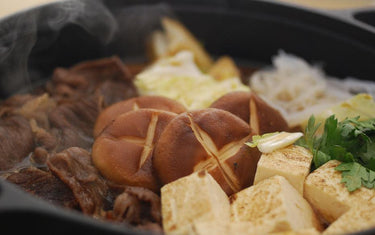What kind of dishes do you think of when you hear the word “Japanese food”? ― Sushi, Sashimi, Tempura, Soba, etc.
“Wagyu (Japanese beef)” is one of the most popular Japanese food among foreigners. Wagyu is expensive and something special even for us Japanese, so is not frequently eaten in our daily life. That is why people always get excited to have “Sukiyaki” on special occasions such as party or year-end family gathering.
What is Sukiyaki?
Sukiyaki is a kind of hotpot in which sliced beef/pork, vegetables and mushrooms are cooked in boiling broth called Warishita (soy sauce, sugar, sake, etc). The ingredients can vary depending on the regions.
The most common ingredients are Wagyu, Chinese cabbage, Japanese leek, Shungiku (chrysanthemum coronarium), Tofu, Shirataki (konjac noodles) and Enoki or Shiitake mushroom etc. Once they are cooked in Warishita, we dip them in beaten raw egg when we eat. Moreover, it is common to put Udon into the remaining Warishita in the end so that you can enjoy Sukiyaki until the very last moment.
We would like to show you how to cook the most standard Sukiyaki.
Ingredients (for 2 servings)
- 200 g of sliced beef
- 1/4 cut of Chinese cabbage
- a bunch of Shungiku
- 1/2 cut of Japanese leek
- 1/2 cut of Tofu
- 100 g of Shirataki
- 4 Shiitake mushrooms
- 5 g of beef tallow
- 2 eggs
- (A)100 cc of soy sauce
- (A)100/ cc of sake
- (A)100 cc of mirin
- (A)3 tbsp of sugar
Preparation
Cut vegetables into bite size pieces and remove Shiitake mushroom stems. Boil Shirataki in hot water to remove unwanted bad smell and then stir-fry it without oil (with this step, it would absorb more soup and flavor later).
Cooking Process
1. Heat and boil Warishita
Put all the ingredients marked with (A) above into a pot to heat it up. Once it boils, lower the heat and remove scum. Then turn off the heat and cool it down.
2. Apply beef tallow on the pan
Warm the pan enough and apply beef tallow on it. Medium heat is recommended to prevent it burning.
3. Grill Japanese leek
Put Japanese leek in and grill it.
4. Pour Warishita into the pan
Once Japanese leek is well grilled, pour Warishita into the pan.
5. Put other ingredients
It is recommended to put vegetables first and beef in the end in order to prevent beef getting overcooked.
6. Steam them well
Put a lid on and lower the heat to steam the ingredients well. When all the vegetables are cooked, it’s ready to eat.
Raw eggs in Japan are safe enough to eat, so it is common to dip the ingredients in a beaten egg when eating Sukiyaki. Even though it already tastes good without egg, it milden Warishita's strong taste.
Finishing with Udon is a must!
Finishing hotpot with rice or noodles is the best part of it. For Sukiyaki, Udon is the most popular and common way to top off. I'd recommend fresh Udon rather than dried one but both would taste good anyway.
Would you like to try out Japanese sukiyaki and wrap up this year with your favorite people?

























